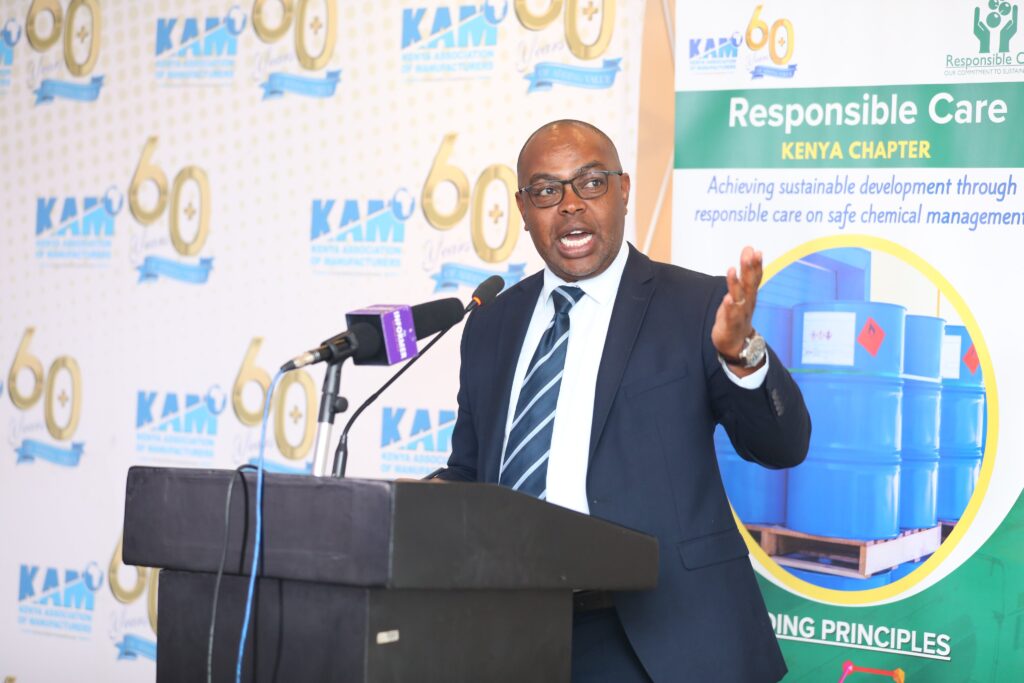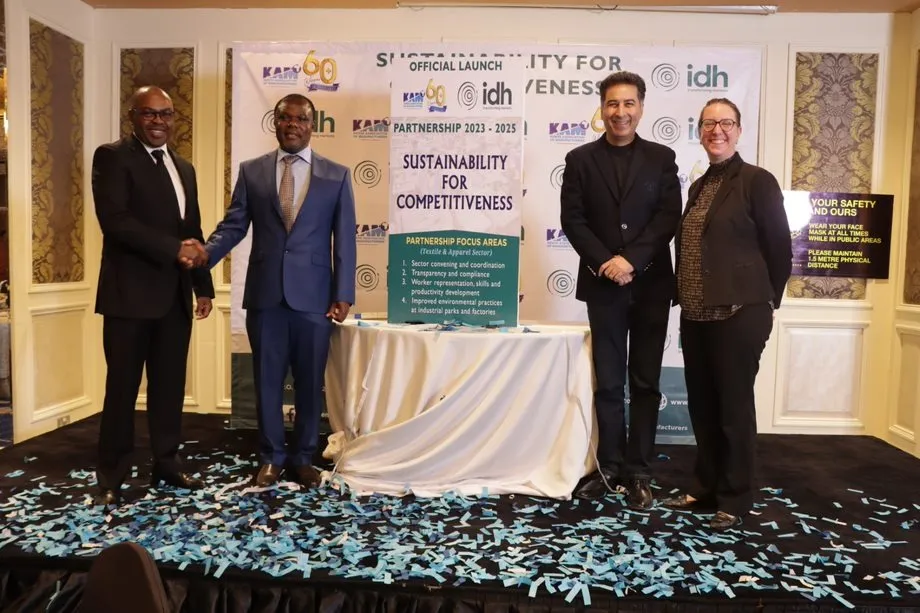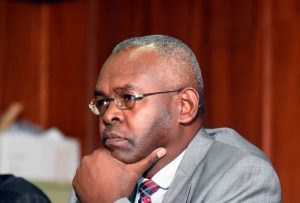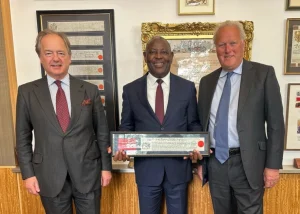
An Excerpt Interview With Kenya Association of Manufacturers (KAM) Chief Executive Office(CEO)Mr.Athony Mwangi on the Industry Success and Achievements;
- Can you elaborate on your expertise in public policy, government relations, stakeholder engagement, communications, and business development?
I am an accomplished professional with over 20 years of experience in Government and Regulatory Affairs, Public Policy, Public Affairs, Communication,Stakeholder Management and Business Development, cutting across various industries, including Transportation,ICT, Aviation, and Oil and gas.
With over 20 years of work experience, I bring on board a wealth of expertise in public policy, government relations, stakeholder engagement, communications and business development.I have previously worked at Bolt, Tullow Oil, IBM and Kenya Airways in various capacities. 
I hold a Master’s Degree in Public Policy and Management from Strathmore Business School (SBS) and a Certificate of Public Policy from New York University (NYU). I am an alumnus of the University of Nairobi and hold other certifications from local and international institutions.- What strategies and initiatives do you have in mind to increase the efficiency and productivity of the local manufacturing sector? How will you foster innovation and technological advancements within the industry?
KAM remains committed to driving the competitiveness of local industry.We do this driven by 4 pillars –Global Competitiveness; Export-led Growth; SME Development; and Agriculture for Industry.
We have in place several initiatives to increase our members’ efficiency and productivity.Some of these include:
Facts-based policy advocacy for an enabling environment for local manufacturers.Enhancing sustainability through our Centre for Green Growth and Climate Change (CGGCC) and Center for Energy Efficiency and Conservation (CEEC).
- Enhancing inclusivity in the manufacturing sector, through the Women in Manufacturing (WIM) Programme and SME Hub.
- Partnership with Moringa School to jointly design and implement a data- driven advocacy strategy for manufacturers, through Moringa School’s Tech programs.Through the data-driven advocacy strategy, KAM and Moringa shall work jointly to use data to inform policy advocacy initiatives and discourse with the government.Through the partnership, Moringa shall provide knowledge and expertise in enhancing digital transformation within the manufacturing sector, graduate placement and offering technical training to KAM Members and Staff.
- Partnership with IDH Kenya to drive the competitiveness of the Textile and Apparel Industry in Kenya. The partnership shall be driven through a 3- year Sustainability for Competitiveness Project. The Project shall focus on good governance; job creation; environmental conservation and restoration; inclusivity and sustainability as well as skills development.
- Partnership with the International Council of Chemical Associations (ICCA) that has seen KAM host Kenya’s Responsible Care Initiative.This is a voluntary initiative for associations and industries who commit to safety, health, environment, and security in handling chemicals through their life cycle. The initiative is guided by seven Responsible Care Codes, namely community awareness and emergency response; employee health and safety; product stewardship; process safety; pollution prevention; distribution; and security.
- Partnership with GIZ to drive the skills agenda for Kenya by providing young graduates with opportunities for practical learning. This is happening through the Technical Vocational and Education Training (TVET) Program. Piloted in 2017 in response to the industry needs for skilled, quality technical expertise and currently, on scaleup, the KAM Technical Vocational Education and Training (TVET) Program acts as a link between manufacturing and value addition industries, technical training institutions, and government/policymakers. The program enhances skills development, providing a pool of technically skilled personnel at entry and middle level to industry in a bid to reduce skills mismatch and the skills gaps within the local workforce.

- In your role as CEO, how do you plan to drive export-led growth and reduce the regulatory burden for manufacturers? Are there any specific partnerships or collaborations you will seek to establish?
When we speak of the country’s competitiveness, we are looking at our ability to sustainably produce goods and services for which there is a market – at a price and quality that the market is willing to pay for.
Importantly, we no longer talk about local competitiveness, but global competitiveness because not only should we be able to sell our products in the domestic markets more competitively than imported products, but at the same time be able to compete in the export markets globally.
For manufacturers to operate effectively and efficiently, they require a business environment that enhances competitiveness.This is through the development of policies and sustainable frameworks to boost the industry’s production, the creation of sustainable jobs and increasing investments. Particularly, the sector needs a predictable and reliable regulatory and tax regime.Predictability allows investors to make projections on long-term investment decisions.
On the other hand, reliability gives the investment community confidence in the stability of the economic policy regime and that commitments made by the government are both binding and lasting.
We continuously engage the government to reduce the regulatory burden for manufacturers. Could you outline your primary goals and priorities as CEO in terms of service delivery to KAM members and the manufacturing sector?
Our priority as an Association remains our members.In my role, I continue to work closely with all stakeholders, including Members, National and County Governments and development partners to increase the efficiency and productivity of the local manufacturing sector, drive export-led growth, reduce the regulatory burden, ease the cost of doing business and advocate for a stable and predictable tax environment and policy.

- Advocating for a stable and predictable tax environment and policy is crucial for the manufacturing sector. How do you intend to engage with relevant stakeholders and authorities to ensure a favourable tax regime?
- One of the biggest challenges facing manufacturers is a high cost and challenging environment for doing business. This includes and not limited to; an unstable and unpredictable tax regime, high cost of energy, unstable industrial policy, illicit trade, and regulatory overreach, among many other challenges.
This is seen every year, with the development of the Finance Bill and the passing and implementation of the Finance Act.
An example is excise duty, which was previously subjected to the annual inflation adjustment every year.We laud the government for the removal of section 10 of the Excise Duty Act that gave the Kenya Revenue Authority (KRA) powers to adjust the specific rate of excise duty once a year to consider inflation.
Unfortunately, other sections of the Finance Act shall deter manufacturing growth.For instance, imposing levies on imported raw materials and intermediate products ostensibly to promote exports, through the Export Promotion and Investment Levy in the Finance Act 2023.KAM sees no economic relationship between imposing levies on the importation of clinker, metal products and packaging paper products with exports.In our view, imposing levies on imports makes Kenya uncompetitive compared to other EAC Partner States.This import levy on raw materials goes against established taxation regimes such as the EAC Common External Tariff (CET) and export-led Duty Remission Scheme (DRS).
We are living in challenging times when the cost of living is at an all-time high.Our focus as a country must be on reducing the cost of commodities and sustaining our economy. We shall continue to engage the government to come up with solutions to these challenges, including finalizing and implementing the National Tax Policy.

- How do you plan to advocate for an enabling environment for a competitive manufacturing sector?
KAM is a dynamic, vibrant, credible and respected business association that unites industrialists and offers a common voice for businesses.The Association provides an essential link for cooperation, dialogue and understanding with the Government by representing the views and concerns of its members to the relevant authorities.
In pursuit of its core mandate of policy advocacy,KAM promotes trade and investment, upholds standards, and encourages the formulation, enactment and administration of sound policies that facilitate a competitive business environment and reduce the cost of doing business. - How do you plan to promote a good company culture within KAM to transform it into a world-class Business Membership Organization (BMO)?
Culture starts at the top.We have a clear mandate from the Board – the Board agenda flows through the organization.Having team members who believe in the company’s mission and values will hugely motivate and energize the entire company and can have a positive effect on the bottom line.
This year, we have implemented the Kaizen methodology to drive productivity across the organization. The game is to continuously rediscover and adopt.As Charles Darwin said of evolution, “It is not the strongest or the most intelligent who will survive but those who can best manage change.” We are learning to be agile and adaptable.
I am driving innovation to spur green manufacturing, data-driven BMO, and thought leadership; we are in the process of making a strategy on how KAM will look in 2033.
I also encourage KAM staff to undertake opportunities for professional growth and development, such as training programs and mentorship. We have created opportunities for the staff to learn cutting-edge technology skills such as Data Analytics,Data Scripting, Data Visualization,Artificial Intelligence, Robotics, and Augmented Reality.All this is geared to make the Secretariat ready to drive the country toward Industry 4.0 or the 4th Industrial Revolution.
- What’s the meaning of 20by30 which KAM has been advocating for some time?
- The share of the manufacturing sector’s contribution to GDP has been fluctuating, reducing from 9.3% in 2016 to 7.2% in 2021 and increasing to 7.8% in 2022 (KNBS, 2023). While the manufacturing sector itself is not shrinking but growing, other sectors such as banking and telco among others, have grown faster than Manufacturing.Despite this trend, KAM and its members are keen to turn this around, beyond the 15% contribution to GDP envisioned by Vision 2030 to a high 20% by 2030, hence calling this Vision 20 by 30.
According to Kenya Vision 2030, a compounded annual GDP growth of 10% will see Kenya’s GDP rise from Ksh 12 trillion in 2021 to Ksh 25 trillion in 2030.
With the manufacturing sector estimated to additionally contribute 1.6% to GDP annually, this will translate to:
1 A rise in jobs created by manufacturing from the current 338,000 to nearly one million. Suffice it to say that manufacturing has the largest number of waged employment outside the public sector.
2.An increase in contribution to public tax coffers from Kes360billion in 2022 to Kes1trillion in 2030
3. An increase in real value-added growth in manufacturing from Ksh 876 billion to Ksh 5.2 trillion. - Could you please briefly describe your work experience in the transportation, ICT, aviation, and oil and gas industries? How have your past experiences in these industries prepared you for the CEO role at KAM?
Before joining KAM, I worked at Bolt as the Head of Public Policy for East Africa & the Horn.I also worked at Tullow Oil as the Director of Government, Public Affairs and Communication and IBM as the Leader of Government and Regulatory Affairs for East Africa from 2012 to 2015.
 While at IBM, I initiated transformative government partnerships, including the Ease of Doing Business Transformation for Kenya. Through this project, IBM Research Lab helped Kenya improve in the World Bank’s Ease of Doing Business ranking globally, from 136 in 2015 to 56 in 2019.
While at IBM, I initiated transformative government partnerships, including the Ease of Doing Business Transformation for Kenya. Through this project, IBM Research Lab helped Kenya improve in the World Bank’s Ease of Doing Business ranking globally, from 136 in 2015 to 56 in 2019.
Before IBM, I worked for Kenya Airways as the Head of Government and Industry Affairs for seven years until November 2012. I have also held senior positions in various organizations, including Samsung Electronics and MFI Office Solutions.
The experiences gained over the years in these roles continue to shape my career and my role as the Chief Executive of the Kenya Association of Manufacturers.
In this role, I am responsible for providing leadership in developing and implementing the KAM Strategic Plan, spearheading advocacy on key issues affecting manufacturers through partnership management and developing and maintaining networks and coalitions with like-minded organizations. This also entails working with the Government to drive manufacturing growth.Further, I am responsible for leading the Secretariat and building strong relationships with the manufacturing business community.I am also in charge of fostering a corporate
identity that promotes values, ethical standards and good governance.










1 thought on “A Big Story: KAM’s Agenda: Kenya’s Manufacturing 20by30”